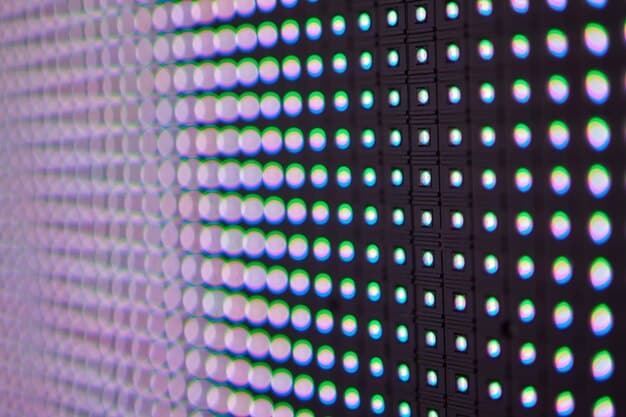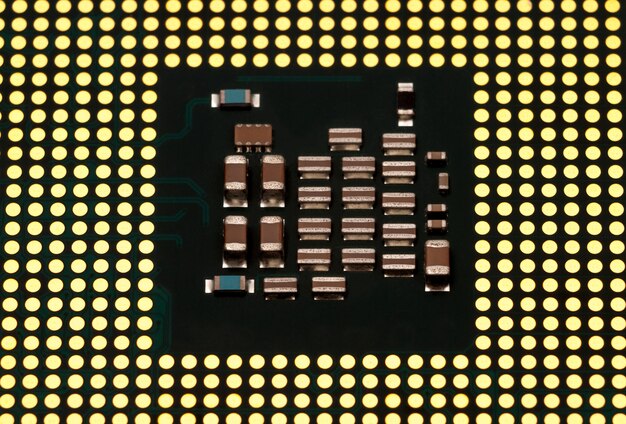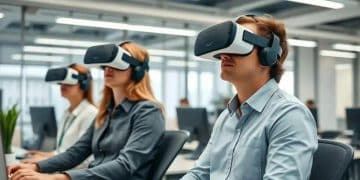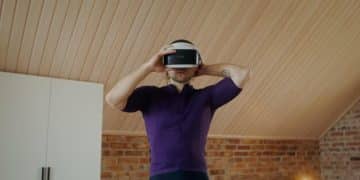Next-Gen VR Displays: Micro-OLED vs. LCD – The 2025 VR Display Showdown

The landscape of VR displays is on the cusp of a major shift, with Micro-OLED and LCD technologies vying for dominance in next-generation headsets, promising enhanced visual fidelity and immersive experiences by 2025.
The future of virtual reality hinges significantly on the technology that powers its displays. As we look towards 2025, the competition between Next-Gen VR Displays: Micro-OLED vs. LCD – Which Technology Will Dominate in 2025? is intensifying, with both technologies pushing the boundaries of visual fidelity and immersive experiences. This article delves into the strengths, weaknesses, and potential of each, offering insights into which display type is poised to lead the VR revolution.
The Evolution of VR Display Technology
VR display technology has come a long way since its inception. Early VR headsets suffered from low resolution, screen-door effect, and sluggish response times, hindering the overall immersive experience. Now, advancements in display technology are tackling these challenges head-on, with Micro-OLED and LCD leading the charge.
The shift towards higher resolution displays, faster refresh rates, and wider fields of view has become essential for creating truly believable virtual environments. This evolution is driven by the demand for more realistic and comfortable VR experiences, pushing manufacturers to innovate and refine existing display technologies.

LCD Technology: A Refined Approach
LCD (Liquid Crystal Display) technology has been a staple in displays for decades, and its adaptability has made it a contender in the VR space. Modern VR LCDs have seen significant improvements, including higher pixel densities and faster response times. However, inherent limitations remain.
- High Brightness: LCDs can achieve high peak brightness levels, which is advantageous for outdoor or brightly lit environments.
- Cost-Effectiveness: LCDs are generally more cost-effective to manufacture compared to Micro-OLED, making them an attractive option for consumer-grade VR headsets.
- Mature Technology: With years of development, LCD technology is well-understood, and manufacturing processes are optimized.
Despite these advantages, LCD’s reliance on a backlight introduces challenges such as imperfect black levels and motion blur. These factors can detract from the overall immersion and visual clarity in VR applications.
LCD technology continues to evolve, with advancements like mini-LED backlights and quantum dot enhancements aimed at improving contrast and color accuracy. These innovations are helping LCDs stay competitive against emerging display technologies in the VR arena.
Micro-OLED: The Rising Star in VR Displays
Micro-OLED (Organic Light Emitting Diode) is rapidly gaining traction as the preferred display technology for next-generation VR headsets. Unlike LCD, Micro-OLED pixels emit their own light, enabling perfect blacks, infinite contrast ratios, and incredibly fast response times.
The self-emissive nature of Micro-OLED translates to a more immersive and visually stunning VR experience. With each pixel capable of turning completely off, blacks appear truly black, and colors pop with vibrancy. This level of contrast significantly enhances depth perception and realism in virtual environments.

Key Advantages of Micro-OLED for VR
Micro-OLED offers several compelling advantages that make it well-suited for VR applications. These benefits directly address some of the shortcomings of LCD technology.
- Superior Contrast: Micro-OLED’s ability to achieve perfect blacks results in unmatched contrast ratios, enhancing the sense of depth and realism.
- Faster Response Times: The rapid switching speed of Micro-OLED pixels minimizes motion blur, providing a smoother and more comfortable VR experience.
- Compact Design: Micro-OLED displays can be incredibly compact, allowing for lighter and more ergonomic VR headsets.
While Micro-OLED excels in many areas, it also faces challenges. Manufacturing Micro-OLED displays with high pixel densities and uniformity can be complex and expensive. Overcoming these hurdles is critical for Micro-OLED to become a mainstream VR display technology.
The self-emissive technology of Micro-OLED also contributes to its energy efficiency. With pixels only drawing power when illuminated, Micro-OLED displays can potentially extend the battery life of wireless VR headsets.
Micro-OLED vs. LCD: A Detailed Comparison
Choosing between Micro-OLED and LCD for VR displays involves carefully weighing their respective strengths and weaknesses. This comparison delves into key performance metrics to help understand the tradeoffs.
Considerations such as resolution, refresh rate, field of view, and overall visual quality all play a crucial role in determining the suitability of each technology for VR applications. By examining these factors, it becomes clearer which display type offers the most compelling experience.
Performance Metrics in VR Displays
Several key performance metrics distinguish Micro-OLED and LCD displays in the context of VR. Understanding these metrics is essential for evaluating the technologies’ potential.
- Resolution: Higher resolution displays offer greater clarity and detail, reducing the screen-door effect and enhancing immersion.
- Refresh Rate: Faster refresh rates minimize motion blur and latency, resulting in a smoother and more comfortable VR experience.
- Contrast Ratio: Higher contrast ratios improve the perception of depth and realism, making virtual environments more engaging.
In terms of resolution, both Micro-OLED and LCD technologies are capable of achieving high pixel densities. However, Micro-OLED’s superior contrast and faster response times give it an edge in overall visual quality. As VR content becomes more demanding, the ability to deliver crisp, fluid visuals will be paramount.
For VR headsets aiming for photorealistic graphics and seamless motion, Micro-OLED’s advantages in contrast and response time are particularly significant. LCD technology, however, remains competitive in terms of brightness and cost-effectiveness.
Cost and Manufacturing Considerations
The cost of manufacturing VR displays is a critical factor influencing their adoption. LCD technology has a long-established infrastructure, making it more cost-effective to produce at scale. Micro-OLED, on the other hand, faces higher manufacturing costs due to its complex production processes.
These cost differences directly impact the price of VR headsets, which can be a barrier to entry for many consumers. As Micro-OLED manufacturing processes mature and production volumes increase, the cost is expected to decrease, making it more competitive.
Supply Chain and Scalability
The availability of display components and the scalability of manufacturing also play a significant role. LCD supply chains are well-established and robust, ensuring a steady supply of components. Micro-OLED supply chains are still developing, which can lead to potential bottlenecks.
- Investment in Manufacturing: Increased investment in Micro-OLED manufacturing facilities is essential to meet the growing demand for VR displays.
- Yield Rates: Improving yield rates in Micro-OLED production can significantly reduce manufacturing costs, making the technology more accessible.
- Competitive Landscape: The entry of more manufacturers into the Micro-OLED market can foster competition and drive down prices.
As Micro-OLED production ramps up and supply chains become more streamlined, the cost gap between Micro-OLED and LCD is expected to narrow. This will make Micro-OLED a more attractive option for a wider range of VR headsets.
The economics of VR display manufacturing will ultimately determine the pace at which Micro-OLED replaces LCD in mainstream VR headsets. Continued innovation and investment in Micro-OLED production are key to its widespread adoption.
The VR Market Landscape in 2025
Looking ahead to 2025, the VR market is poised for continued growth and innovation. Several factors will shape the competitive landscape, including advancements in display technology, content availability, and headset affordability.
The battle between Micro-OLED and LCD will play a pivotal role in shaping the VR experience. As consumers demand more immersive and visually stunning virtual environments, the choice of display technology will become increasingly important.
Trends Shaping the VR Industry
Several key trends are influencing the direction of the VR industry. These trends are driving innovation and adoption, creating new opportunities for display technologies like Micro-OLED and LCD.
- Wireless VR: The demand for wireless VR headsets is growing, requiring display technologies that are energy-efficient and lightweight.
- Extended Reality (XR): The convergence of VR and augmented reality (AR) is creating new use cases and demanding more versatile display technologies.
- Metaverse: The rise of the metaverse is driving the need for more immersive and social VR experiences, pushing the boundaries of display technology.
Micro-OLED’s compact design and energy efficiency make it well-suited for wireless VR headsets. Its superior contrast and fast response times also contribute to a more immersive metaverse experience. LCD technology, with its cost-effectiveness, will continue to be a viable option for entry-level VR headsets.
The VR market in 2025 will likely see a mix of display technologies, with Micro-OLED catering to high-end users and LCD serving the mainstream market. As Micro-OLED becomes more affordable, it is expected to gain a larger share of the VR display market.
Predicting the Dominant Technology
Predicting which display technology will dominate the VR market in 2025 requires considering various factors, including technological advancements, cost reductions, and market trends. While both Micro-OLED and LCD have their strengths, Micro-OLED appears to be gaining momentum.
The superior visual quality and performance of Micro-OLED are increasingly appealing to VR enthusiasts and professionals. As manufacturing processes improve and costs decrease, Micro-OLED is poised to become the dominant display technology in high-end VR headsets.
| Key Point | Brief Description |
|---|---|
| ✨ Micro-OLED Advantages | Superior contrast, faster response times, and compact design for high-end VR. |
| 💰 LCD Affordability | Cost-effective and widely used, suitable for entry-level and mid-range VR headsets. |
| 📈 Market Trends | Demand for wireless VR and immersive metaverse experiences favors Micro-OLED. |
| 🏭 Manufacturing Costs | Micro-OLED costs are decreasing, but LCD remains more affordable for mass production. |
Frequently Asked Questions
▼
Micro-OLED displays are self-emissive, offering superior contrast and response times, while LCDs use a backlight, making them more cost-effective but with lower contrast and slower response.
▼
Micro-OLED is generally considered better for high-end VR due to its superior visual quality, but LCD remains a viable option for budget-friendly VR headsets.
▼
Higher manufacturing costs of Micro-OLED currently limit its use to high-end devices, but as production scales, costs are expected to decrease, increasing adoption.
▼
The metaverse drives demand for more immersive VR experiences, favoring technologies like Micro-OLED that offer better visual fidelity and realism to enhance the user presence.
▼
Wireless VR headsets offer greater freedom of movement and convenience, requiring energy-efficient displays like Micro-OLED to maximize battery life while maintaining quality.
Conclusion
In conclusion, as we approach 2025, both Micro-OLED and LCD technologies will continue to shape the VR display landscape. While LCD maintains its position in cost-sensitive applications, Micro-OLED’s superior performance characteristics position it as the likely dominant technology in the high-end VR market, driving innovation and delivering increasingly immersive virtual experiences.





